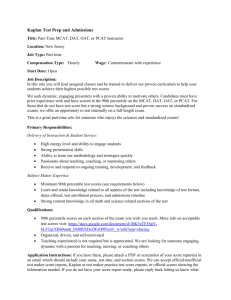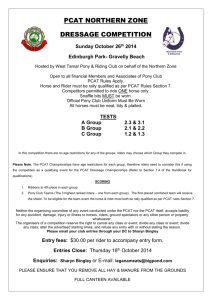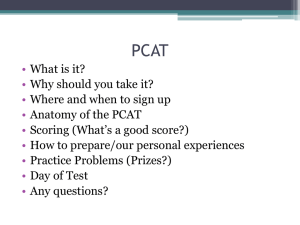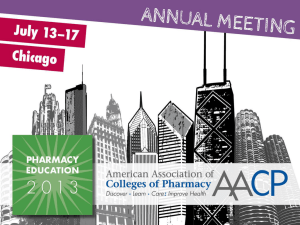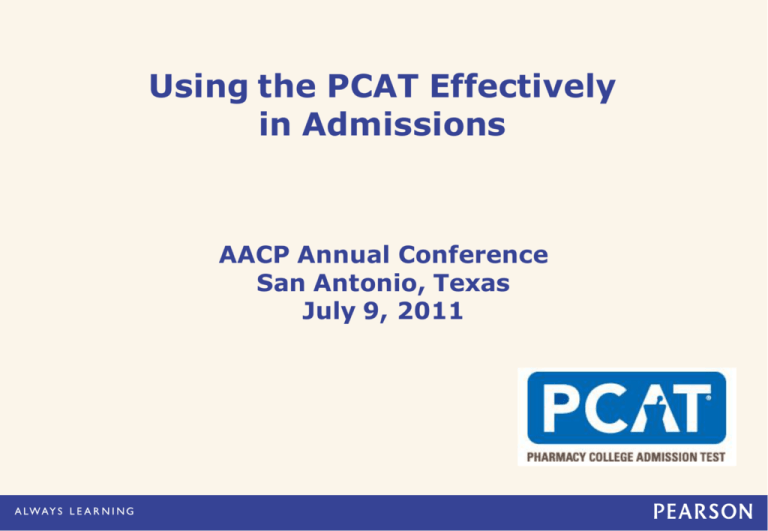
Using the PCAT Effectively
in Admissions
AACP Annual Conference
San Antonio, Texas
July 9, 2011
Agenda
•
•
•
•
•
•
Welcome and Introduction
PCAT Computer-Based Test
Interpreting PCAT Scores
Official PCAT Practice Test
PCAT 2012-2013 Blueprint Updates
Admission Feedback
Copyright © 2011 NCS Pearson, Inc. All rights reserved.
PCAT Computer-Based Test
•
A computer-based pilot
was administered in
October 2010 at Pearson
VUE testing centers in
the United States.
• The results showed that
the observed differences
between CBT and PPT
matched samples were
not great enough to
require equating.
• All CBT scores were
reported as obtained
using the same rawscore-to-scaled-score
tables as PPT scores.
Means, Standard Deviations (SD), and Effect Size Data for CBT and PPT
Matched Samples (CBT n = 577; PPT n = 577)
PCAT Subtest
Format Mean
CBT 402.3
SD
19.1
Min. Max.
330
478
Effect
Size
PPT
402.5
19.3
351
461
CBT
408.5
18.1
333
466
Biology
PPT
CBT
408.9
396.9
17.5
19.7
363
341
466
458
0.019
Reading Comprehension
PPT
397.4
18.7
341
471
0.022
Quantitative Ability
CBT
PPT
CBT
400.3
400.8
406.2
14.9
15.1
18.3
350
360
356
457
457
472
0.026
Chemistry
PPT
405.7
18.6
360
472
0.019
CBT
2.855
0.44
1.5
4
PPT
2.867
0.34
1.5
4
CBT
2.865
0.42
1
4
PPT
2.912
0.31
1
4
Verbal Ability
Conventions of Language
Problem Solving
0.008
0.021
0.092
Note : CBT = Computer-based test. PPT = Paper-and-pencil-based test.
Effect Size = Based on mean differences between samples in terms of
standard deviation units (Cohen's d ). Matched Samples = Sample
individuals matched by propensity scores (based on previous PCAT
scores and demographic characteristics ).
Copyright © 2011 NCS Pearson, Inc. All rights reserved.
PCAT Computer-Based Test
•
Computer-based testing begins in July 2011 at Pearson VUE Test
Centers.
•
Candidates will register at PCATweb.info and schedule at
PEARSONVUE.com/PCAT.
•
Candidates will receive a preliminary unofficial
score report for multiple-choice subtests
at the Test Center.
•
Multiple-choice subtests and essays will
continue to be scored and officially
reported by Pearson.
Copyright © 2011 NCS Pearson, Inc. All rights reserved.
PCAT Computer-Based Test
PCAT information is available at:
• YouTube videos at
www.youtube.com/PearsonFieldResearch
• The most up-to-date and comprehensive information can be
found in the Candidate Information Booklet (CIB) at
PCATweb.info which is available at pharmacy schools and
admissions offices.
• CBT testing tutorial available at PEARSONVUE.com/PCAT
• Follow us soon on Twitter.
Copyright © 2011 NCS Pearson, Inc. All rights reserved.
PCAT Computer-Based Test
•
•
•
•
•
•
Steps to sign up for the 2011-2012 PCAT are:
Register at PCATweb.info
Receive a confirmation email and proceed to schedule
preferred testing date, time, and location at
PEARSONVUE.com/PCAT
Pearson strongly suggests that candidates register
and schedule by the “Register and Schedule By” date
to receive preferred testing date, time, and location.
Confirmation emails with next steps are sent to
candidates.
Security at the Test Centers will include biometric ID,
palm vein, digital signature and photo of candidate
Copyright © 2011 NCS Pearson, Inc. All rights reserved.
PCAT Computer-Based Test
Benefits:
• Increased security at Test Centers
• Unofficial Preliminary Score Report given to candidates immediately
following test administration
• Scores reported to PharmCAS and pharmacy schools in less time
than with paper-and-pencil administration
• Positive feedback from candidates indicates test is user-friendly,
and VUE Test Centers provide a comfortable testing environment
Copyright © 2011 NCS Pearson, Inc. All rights reserved.
Interpreting PCAT Scores
Score Reporting
• A personal Official Score Report will be available online at the
PCAT website by logging in to the candidate’s profile.
• Official Transcripts, showing all PCAT scores earned within the
previous five years, are sent to institutions, either printed (via
mail) or electronically (via SFTP for Pearson subscribers or via
PharmCAS).
• Pharmacy schools receiving paper transcripts receive a
summary of all candidates whose scores were sent to their
institution.
Copyright © 2011 NCS Pearson, Inc. All rights reserved.
Interpreting PCAT Scores
PCAT personal Official Score Reports and Official Transcripts
present three types of scores
• Scaled Scores
• Percentile Ranks
• Writing Scores
Neither Pearson nor AACP establishes passing scores for
individual PCAT subtests or for the PCAT as a whole. It is the
responsibility of each school of pharmacy to determine how it
uses PCAT scores.
Copyright © 2011 NCS Pearson, Inc. All rights reserved.
Interpreting PCAT Scores
Scaled Scores
• Range from 200-600, making scores directly comparable
across test forms and from year to year
• Reported for the 5 multiple-choice subtests and
Composite score
Percentile Ranks
• Range from 1-99
• Indicate a candidate’s performance relative
to the current PCAT normative sample (all
first-time examinees from October 2004
through May 2007)
• Are provided for each of the 5 multiplechoice subtests and the Composite score
Copyright © 2011 NCS Pearson, Inc. All rights reserved.
Interpreting PCAT Scores
Writing Scores
• Range from 1.0 to 5.0
• Two scores are reported
• Conventions of Language
• Problem Solving
• Both Writing scores represent an average of scores
assigned by two scorers.
• For example, a score of 4.5 is the average of one scorer
assigning a 4.0 and another scorer assigning a 5.0.
Copyright © 2011 NCS Pearson, Inc. All rights reserved.
Interpreting PCAT Scores
Mean Writing Scores
• The mean Writing scores differ from PCAT test date
to test date, reflecting
• differences in prompt content
• slight differences in prompt difficulty, and
• differences in the group of candidates sitting
for the PCAT on that test date.
• For this reason, a candidate’s Writing scores should
always be evaluated relative to the mean scores for
the test date on which the scores are earned.
Copyright © 2011 NCS Pearson, Inc. All rights reserved.
Interpreting PCAT Scores
Official Transcript Sample
Copyright © 2011 NCS Pearson, Inc. All rights reserved.
Interpreting PCAT Scores
PCAT SSN Reporting
• Pearson believes the practice of identifying candidates using
full SSNs is unnecessary and could expose candidates to
identity theft in the event data are compromised in any way.
• Pearson is therefore using only the last four SSN digits to
identify a candidate.
• The PCAT CID (Candidate ID) is unique and can be used to
match candidates.
Copyright © 2011 NCS Pearson, Inc. All rights reserved.
Reliability and Validity
Reliability
• Satisfactory internal consistency for multiple-choice subtest
and Composite scores (K-R 20 = 0.80-0.95)
• High inter-rater reliability (0.98 and above) for Writing scores
Validity
• Intercorrelations among PCAT subtest and Composite scores
(2010-11)
PCAT Subtest
Verbal Ability
Vbl.
—
Bio.
—
Rdg.
—
Quant.
—
Chem.
—
Comp.
—
W: CL
—
Biology
0.54
—
—
—
—
—
—
Reading Comprehension
0.67
0.47
—
—
—
—
—
Quantitative Ability
0.33
0.45
0.34
—
—
—
—
Chemistry
0.35
0.57
0.33
0.60
—
—
—
Composite
0.77
0.80
0.74
0.71
0.76
—
—
Writing: Conventions of Language
0.22
0.15
0.24
0.13
0.13
0.23
—
Writing: Problem Solving
0.23
0.17
0.25
0.13
0.13
0.24
0.81
Copyright © 2011 NCS Pearson, Inc. All rights reserved.
Reliability and Validity
Predictive Validity
Correlations Between Predictors and GPA in First Year of Pharmacy Program (N = 2,244)
First Year GPA
Uncorrected
Corrected
Variable
r
r*
PCAT Verbal Ability SS
0.13
0.16
PCAT Biology SS
0.26
0.35
PCAT Reading Comprehension SS
0.17
0.24
PCAT Quantitative Ability SS
0.21
0.28
PCAT Chemistry SS
0.29
0.36
PCAT Composite SS
0.32
0.44
PCAT Writing: Conventions of Language
0.06
PCAT Writing: Problem Solving
0.06
Entering GPA: Cumulative
0.44
Entering GPA: Math
0.28
Entering GPA: Science
0.44
From: Meagher, D. G., Pan, T., & Perez, C. P. (2011). Predicting performance in the first-year of pharmacy school.
American Journal of Pharmaceutical Education, 75(5), Article 81.
Abbreviations: SS = Scaled Score; GPA = grade point average; r = correlation coefficient; r2 = the percent of one
variable explainable by another variable
All correlations are weighted means of the correlations for the 22 schools combined based on Fisher's z
transformations; the corrected correlations were done using the formula of Cohen, et al. (2003, p. 58).
Copyright © 2011 NCS Pearson, Inc. All rights reserved.
The Official PCAT Practice Test
• Official PCAT Practice Test proven
to increase scores
• Examinees who took the Official PCAT
Practice Test:
• Averaged higher on the actual PCAT
compared to those who have not taken
the Official PCAT Practice Test.
• Showed a significant increase in
their scores on their 2nd attempt of
the actual PCAT.
Diagnostic Report assesses performance and evaluates strengths and
weaknesses by suggesting areas that need review
Copyright © 2011 NCS Pearson, Inc. All rights reserved.
Data on PCAT OPT Performance 2010-11
PCAT Subtest/Composite
Verbal Ability
Biology
Reading Comprehension
Quantitative Ability
Chemistry
Composite
Writing: Conventions of Language
Writing: Problem Solving
n
Prior to 1st Attempt PCAT
0 OPT
1 OPT
2 OPTs
3 OPTs
401.6
409.8
412.5
414.1
404.5
413.5
418.2
422.1
397.1
404.1
405.9
408.2
400.9
409.0
416.1
418.6
402.2
414.3
422.6
429.1
401.3
410.1
415.1
418.4
2.82
2.89
2.87
2.93
2.87
2.92
2.89
2.96
16,407
738
431
445
Note: 0 OPT = cases that took first-attempt PCAT but did not take an OPT first; 1 OPT = cases that took one
OPT before taking the first-attempt PCAT; 2 OPTs = cases that took two OPTs before taking the first-attempt
PCAT; 3 OPTs = cases that took three OPTs
Copyright © 2011 NCS Pearson, Inc. All rights reserved.
PCAT Blueprint
Current PCAT Blueprint 2011-12
Number of
Number of Core Experimental
PCAT Subtest
Items
Items
1 Prompt (either operational or
Part 1: Writing
experimental)
Part 2: Verbal Ability
40
8
Analogies
25
5
Sentence Completion
15
3
Part 3: Biology
40
8
General Biology
25
4–5
Microbiology
7–8
1–2
Anatomy & Physiology
7–8
1–2
Part 4: Chemistry
40
8
General Chemistry
25
5–6
Organic Chemistry
15
2–3
Rest Break
1 Prompt (either operational or
experimental)
Part 5: Writing
Part 6: Reading Comprehension
40 / 5 passages
8 / 1 passage
Comprehension
12–13
2–3
Analysis
15
3–4
Evaluation
12–13
2–3
Part 7: Quantitative Ability
40
8
Basic Math
5–6
1–2
Algebra
7–8
1–2
Probability & Statistics
7–8
1–2
Pre-Calculus
9–10
2–3
Calculus
9–10
2–3
40 multiple200 multiplechoice items +
Total Test
choice items + 1
1 writing
writing prompt
prompt
Copyright © 2011 NCS Pearson, Inc. All rights reserved.
New PCAT Blueprint 2012-13
Time Allowed
30 min.
30 min.
PCAT Subtest
Part 1: Writing
Part 2: Verbal Ability
Number of Core
Items
1 Prompt (either operational or
experimental)
40
8
Analogies
30 min.
Sentence Completion
Part 3: Biology
General Biology
Microbiology
30 min.
Variable
30 min.
50 min.
40 min.
25
5
15
40
3
8
20–22
4–5
7–8
1–2
12–13
40
2–3
8
General Chemistry
20–22
4–5
Organic Chemistry
12–13
2–3
7–8
1–2
Anatomy & Physiology
Part 4: Chemistry
Basic Biochemistry Processes
Rest Break
Part 5: Writing
Part 6: Reading Comprehension
1 Prompt (either operational or
experimental)
8 / 1 passage
Comprehension
Analysis
12–13
14–15
2–3
3–4
Evaluation
12–13
2–3
Part 7: Quantitative Ability
40
8
5–6
7–8
1–2
1–2
Probability & Statistics
7–8
1–2
Pre-Calculus
9–10
2–3
Calculus
9–10
2–3
200 multiple-choice
items + 1 writing
prompt
40 multiplechoice items + 1
writing prompt
Total Test
Time Allowed
30 min.
30 min.
30 min.
30 min.
Variable
40 / 5 passages
Basic Math
Algebra
240 min. = 4 hrs.
+ Rest Break
Number of
Experimental
Items
30 min.
50 min.
40 min.
240 min. = 4 hrs.
+ Rest Break
PCAT Blueprint 2012-13
2011 –
2012
2012 –
2013
60%
50%
Cellular and Molecular Biology
15%
17%
Diversity of Life Forms
15%
17%
Ecology
5%
––
Plants, Algae and Fungi
5%
––
Animals
10%
––
Health
10%
17%
Biology Content
General Biology
Copyright © 2011 NCS Pearson, Inc. All rights reserved.
Biology (approximate percentages
for each content objective)
PCAT Blueprint 2012-13
Copyright © 2011 NCS Pearson, Inc. All rights reserved.
Chemistry (approximate
percentages for each content
objective)
Admission Feedback
1. Do you currently use PCAT scores?
Copyright © 2011 NCS Pearson, Inc. All rights reserved.
1. Do you currently use PCAT scores?
1.
2.
Yes
No
87%
13%
1
Copyright © 2011 NCS Pearson, Inc. All rights reserved.
2
2. If you are currently using PCAT scores, are you satisfied
that the current scores adequately reflect candidates’ skills
and abilities?
Copyright © 2011 NCS Pearson, Inc. All rights reserved.
2. If you are currently using PCAT scores, are you satisfied
that the current scores adequately reflect candidates’ skills
and abilities?
58%
1. Yes
2. No
42%
1
Copyright © 2011 NCS Pearson, Inc. All rights reserved.
2
3. Do you currently or would you like to be able to assess
applicants’ humanistic behavioral characteristics as part of
your program’s admissions process?
Copyright © 2011 NCS Pearson, Inc. All rights reserved.
3. Do you currently or would you like to be able to assess
applicants’ humanistic behavioral characteristics as part of
your program’s admissions process?
Yes, I do currently.
2. No, not interested.
3. No, but would like to assess
in the future.
1.
57%
39%
4%
1
Copyright © 2011 NCS Pearson, Inc. All rights reserved.
2
3
4. Would the addition of a PCAT score reflecting candidates’
knowledge of behavioral and social science content be of
value?
Copyright © 2011 NCS Pearson, Inc. All rights reserved.
4. Would the addition of a PCAT score reflecting candidates’
knowledge of behavioral and social science content be of
value?
1. Yes
2. No
57%
43%
1
Copyright © 2011 NCS Pearson, Inc. All rights reserved.
2
5. Would an assessment of candidates’ humanistic behavioral
characteristics separate from the PCAT be of value?
Copyright © 2011 NCS Pearson, Inc. All rights reserved.
5. Would an assessment of candidates’ humanistic behavioral
characteristics separate from the PCAT be of value?
1. Yes, this would be of value
2. No, this would not be of
value
3. Uncertain
71%
23%
6%
1
Copyright © 2011 NCS Pearson, Inc. All rights reserved.
2
3
Additional Comments?
Copyright © 2011 NCS Pearson, Inc. All rights reserved.
Reference Links
PCAT Technical Manual and PCAT Score
Interpretation Quick Reference
www.aacp.org/resources/academicpolicies/adm
issionsguidelines/Pages/PharmacyCollegeAdmis
sionsTest.aspx
PCAT Website
www.PCATweb.info
PCAT Validity Study published in AJPE
www.aacp.org/resources/academicpolicies/adm
issionsguidelines/Documents/PCATPredictiveVali
dityStudy--GeneralReport.pdf
www.ajpe.org/aj7sos/aj750581.pdf
Copyright © 2011 NCS Pearson, Inc. All rights reserved.
Contacts:
Cindy Agonis
Cindy.Agonis@Pearson.com
210-339-5302
Don Meagher
Don.Meagher@Pearson.com
210-339-5297

